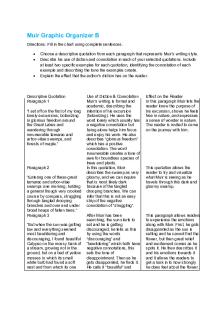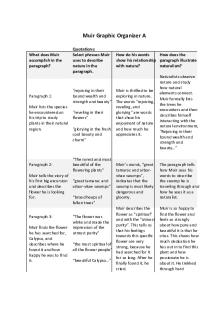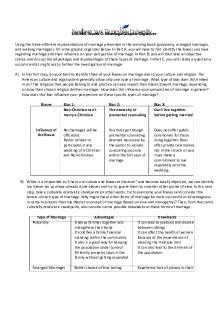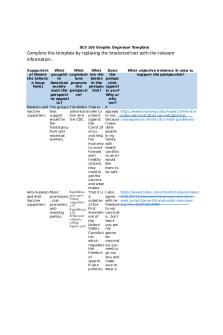Muir Graphic Organizer B - Google Docs PDF

| Title | Muir Graphic Organizer B - Google Docs |
|---|---|
| Course | English Structure and Pedagogical Grammar |
| Institution | Minnesota State University-Mankato |
| Pages | 4 |
| File Size | 137.3 KB |
| File Type | |
| Total Downloads | 29 |
| Total Views | 151 |
Summary
here is an assignment I did as a freshman on FLVS ENGLISH 9th grade TOOK ME AN HOUR AND I WANTED TO UPLOAD IT her its for the Muir and Wordsworth essay...
Description
Muir Graphic Organizer B
Directions: Fill in the chart using complete sentences.
● ●
●
Choose a descriptive quotation from each paragraph that represents Muir’s writing style. Describe his use of diction and connotation in each of your selected quotations. Include at least two specific examples of connotative words for each quotation, identifying the connotation of each example and describing the tone the examples create. Explain the effect that the author’s diction has on the reader.
Descriptive Quotation
Paragraph 1 “I set off on the first of my long lonely excursions, botanizing in glorious freedom around the Great Lakes and wandering through innumerable Tamarac and arbor-vitae swamps, and forests of maple”
Paragraph 2
“Entering one of these great Tamarac and arbor-vitae swamps one morning, holding
Use of Diction & Connotation
Effect on the Reader
Muir’s writing is formal and academic, describing the intention of his excursion (botanizing). He uses the word lonely which usually has a negative connotation, but being alone helps him focus and enjoy his work. He also describes “glorious freedom” which has a positive connotation. The word innumerable creates a tone of awe for boundless species of trees and plants.
In this paragraph Muir lets the reader know the purpose of his excursion, shows he feels free in nature and expresses a sense of wonder in nature. The reader is invited to come on the journey with him.
In this quotation, Muir describes the swamp as very gloomy, and we can inquire that is most likely dark because of the tangled drooping branches. We can infer that this is not an easy strip of the negative connotation of “struggling”.
This quotation allows the reader to try and visualize what Muir is seeing as he travels through this dark and gloomy swamp.
a general though very crooked course by compass, struggling through tangled drooping branches and over and under broad heaps of fallen trees.” In this quotation,
Paragraph 3
But when the sun was getting low and everything seemed most bewildering and discouraging, I found beautiful Calypso on the mossy bank of a stream, growing not in the ground, but on a bed of yellow mosses in which its small white bulb had found a soft nest and from which its one flower sprung.
After Muir has been searching, the sun starts to set and he is getting discouraged, he tells us this by using the words “discouraging” and “bewildering” which both have negative connotations, this sets the tone of disappointment. Then as he gets disappointed, he finds it. He calls it “beautiful” and describes how and where it is growing. The word “beautiful” has a positive connotation that lightens the mood and sets a happy tone.
This paragraph allows readers to experience the emotions along with Muir. First, he gets disappointed as the sun is setting and he cannot find the flower, but then great relief and excitement comes as he spots it. He then describes it and his emotions towards it and it allows the readers to get a look into how strongly he does feel about the flower.
Paragraph 4
“It seems wonderful that so frail and lovely plant has such power over human hearts.”
Paragraph 5
“Hunger and weariness vanished, and only after the sun was slow in the west I splashed on through the swamp, strong and exhilarated as if never to feel any mortal care.”
Muir is describing the flower and how in awe he is of it and how “wonderful” it is that it holds so much “power” over human hearts. Wonderful has a positive connotation. The way that the author phrases the words sets the tone for curiosity because he is questioning/in awe of how wonderful the flower is.
This statement gives readers a moment to think along with Muir about nature and the meaning of the flowers and the importance they have in our lives and the philosophy behind them and nature itself.
After Muir finds the flower, he stays with it until he is very hungry and tired. Then, after the sun comes, he gets up and as if the flower has given him energy, goes his way back. He uses the word “exhilarated” to describe this and it has a positive connotation because it gave him motivation which gives us a determined tone.
Again, the readers can go along with the emotions that Muir feels as he starts to get tired and hungry laying next to the flower. Then, he gets a sudden determination and goes on to head back. This can give us determination and lift our moods just like it did Muir’s.
Paragraph 6
“With one of these large backwoods loaves I was able to wander many a long fertile mile in the forests and bogs, free as the winds, gathering plants, and glorying in God’s abounding inexhaustible spiritual beauty bread.
After he gets out of the swamp, he wanders around the woods and gets food (bread) from the farmers he comes across. After being in nature for so long he starts to become very connected to it and appreciate it. He describes the woods and how free he feels. He then compares it to the plants “glorifying” God. The word “glorifying” has a positive connotation and gives a very positive and free tone.
The readers finally get a semi-full view of how Muir feels about nature. He embraces it and it makes him feel free. This can give us an insight into how we can embrace nature and appreciate its beauty....
Similar Free PDFs

Muir Graphic Organizer B
- 2 Pages

Muir Graphic Organizer A
- 2 Pages

Graphic Organizer
- 3 Pages

SCS 100 Graphic Organizer
- 1 Pages

Wordsworth Graphic Organizer A
- 2 Pages

Amanda Lang Graphic Organizer
- 4 Pages

Graphic Organizer Table
- 6 Pages

Spacecat Graphic Organizer
- 1 Pages

Graphic Organizer - Rizal
- 2 Pages

Graphic Organizer on Marriage
- 2 Pages

Final Graphic Organizer-2
- 3 Pages
Popular Institutions
- Tinajero National High School - Annex
- Politeknik Caltex Riau
- Yokohama City University
- SGT University
- University of Al-Qadisiyah
- Divine Word College of Vigan
- Techniek College Rotterdam
- Universidade de Santiago
- Universiti Teknologi MARA Cawangan Johor Kampus Pasir Gudang
- Poltekkes Kemenkes Yogyakarta
- Baguio City National High School
- Colegio san marcos
- preparatoria uno
- Centro de Bachillerato Tecnológico Industrial y de Servicios No. 107
- Dalian Maritime University
- Quang Trung Secondary School
- Colegio Tecnológico en Informática
- Corporación Regional de Educación Superior
- Grupo CEDVA
- Dar Al Uloom University
- Centro de Estudios Preuniversitarios de la Universidad Nacional de Ingeniería
- 上智大学
- Aakash International School, Nuna Majara
- San Felipe Neri Catholic School
- Kang Chiao International School - New Taipei City
- Misamis Occidental National High School
- Institución Educativa Escuela Normal Juan Ladrilleros
- Kolehiyo ng Pantukan
- Batanes State College
- Instituto Continental
- Sekolah Menengah Kejuruan Kesehatan Kaltara (Tarakan)
- Colegio de La Inmaculada Concepcion - Cebu




